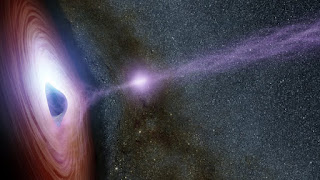During the period when our ancient ancestors were evolving learning to walk use their hands and create basic tools remarkable cosmic events were shaping our galaxy. However we as an advanced society today can only observe and understand these phenomena after millions of years have passed. It's fascinating to think that this occurred during a time when civilization as we know it was still from existence.
Astronomers have meticulously tracked the path of a hypervelocity star called S5 HVS1 over time. Their findings suggest that this star was actually ejected from the black hole at the center of our galaxy back when our current civilization did not even exist.
S5 HVS1 is classified as an "A type main sequence star". Holds the impressive title of being the fastest star astronomers have ever discovered. Its trajectory measurements show that it is moving at a speed of approximately 1,755 km/s or roughly four million miles per hour.
According to experts in astronomy this ejection event took place around five million years ago. Provides evidence for what is known as the Hills mechanism. This mechanism occurs when a binary star system is disrupted by a black hole.
In our Milky Way Galaxy we are home to Sagittarius A*, which is a supermassive black hole with a mass nearly four million times greater, than that of our Sun.
The Hills mechanism illustrates how stars are separated and allowed to continue their journeys.
In 2019 astronomers made a measurement of a star being pulled into orbit around a black hole while its companion star was launched into intergalactic space at an incredibly high velocity.
To understand the origin of S5 HVS1 astronomers studied its movement. Traced back its orbit in time. Surprisingly they discovered that the stars path could be traced back to the Galactic Center of our Milky Way galaxy. It was expelled from there 5 to 4.8 million years ago at a speed of 1800km/s. This makes S5 HVS1 not only the first clear example of the Hill Mechanism but also one of the fastest stars in our galaxy.
This particular star was observed as it approached Earth on its journey from a distance of 29,000 light years away. It was traveling than ten times faster than any other star in the Milky Way Galaxy.
Its velocity is so immense that astronomers predict it will eventually escape from our Milky Way galaxy and never return again.
This discovery holds importance and has surprised many astronomers. For years they have speculated about Black Holes ejecting stars at speeds but this is the first time they have been able to link a fast moving star with the black hole, at the center of our galaxy.
The trajectory of S5 HVS1 is of importance to astronomers as it is believed to have originated in the galactic center. Additionally it holds a quality as the conditions in the core of our Milky Way galaxy differ significantly from those found in our local galactic surroundings making S5 HVS1 akin to a fascinating "visitor, from another realm".


Post a Comment